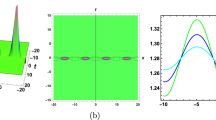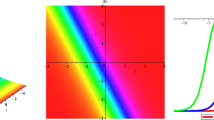Abstract
The electromagnetic propagation in plasma media can be conveniently modeled using finite difference time domain method based on the matrix exponential (ME-FDTD) method. The Maxwell’s curl equations and the constitutive relations between the flux density and the electric field can be looked as a first order differential matrix system. The fundamental solution to such a system is derived in terms of matrix exponential and the update equations can be extracted conveniently from the solution. This has the advantages of presenting a more concise formulation. The ME-FDTD algorithm is validated by comparing the simulation results with the analytical values. Numerical results show that the ME-FDTD can acquire high efficiency with less computer consumption and has a good performance of flexibility and simplicity.





Similar content being viewed by others
References
R. J. Luebbers and F. Hunsberger, “FDTD for N th-order dispersive media,” IEEE Transaction Antennas Propagat 40, 1297–1301 (1992).
R. Siushansian and J. LoVetri, “A comparison of numerical techniques for modeling electromagnetic dispersive media,” IEEE Microwave Guided Wave Lett 5, 426–428 (1995).
Y. Takayama and W. Klaus, “Reinterpretation of the Auxiliary differential equation method for FDTD,” IEEE Microwave Wireless Components Lett 12 (3), 102–104 (2002).
D. M. Sullivan, “Frequency-dependent FDTD methods using Z transforms,” IEEE Trans Antennas Propagat 40, 1223–1230 (1992).
J. A. Pereda, A. Vegas, and A. Prieto, “FDTD modeling of wave propagation in dispersive media by using the Mobius transformation technique,” IEEE Trans. Microwave Theory Tech 50 (7), 1689–1695 (2002).
Q. Chen, M. Katsurai, and P. H. Aoyagi, “An FDTD formulation for dispersive media using a current density,” IEEE Trans Antennas Propagat 46, 1739–1745 (1998).
D. F. Kelley and R. J. Luebbers, “Piecewise linear recursive convolution for dispersive media using FDTD,” IEEE Trans Antennas Propagat 44, 792–797 (1996).
J. L. Young, “Propagation in linear dispersive media: Finite difference time-domain methodologies,” IEEE Trans Antennas Propagat 43, 422–426 (1995).
J. L. Young, “A higher order FDTD method for EM propagation in collisionless cold plasma,” IEEE Trans Antennas Propagat 44, 1283–1289 (1996).
S. Liu, N. Yuan, and J. Mo, “A novel FDTD formulation for dispersive media,” IEEE Microwave Wireless Components Lett 13 (5), 187–189 (2003).
Sh J. Huang, “Exponential time differencing FDTD formulation for plasma,” Microw Opt Technol Lett 49 (6), 1363–1364 (2007).
S. Liu, S. Y. Zhong, and S. B. Liu, “Finite-difference time-domain algorithm for dispersive media based on Runge-Kutta exponential time differencing method,” Int J Infrared Millim Waves 29 (3), 323–328 (2008).
I. E. Leonard, “The matrix exponential,” SIAM REVIEW 38 (3), 507–512 (1996).
J. P. Berenger, “A perfectly matched layer for the absorption of electromagnetic waves,” J Comput Phys 114 (1), 185–200 (1994).
Acknowledgment
The work is supported by State Key Laboratory of Millimeter Waves Open Research Program (K200802) & The Provincial Education Science Foundation of Jiangxi.
Author information
Authors and Affiliations
Corresponding author
Rights and permissions
About this article
Cite this article
Liu, S., Liu, S. Simulation of Electromagnetic Wave Propagation in Plasma Using Matrix Exponential FDTD Method. J Infrared Milli Terahz Waves 30, 1020–1026 (2009). https://doi.org/10.1007/s10762-009-9528-0
Received:
Accepted:
Published:
Issue Date:
DOI: https://doi.org/10.1007/s10762-009-9528-0




